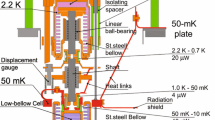Abstract
TEMPERATURES sensibly lower than those usually attained by pumping liquid helium are accessible now that the design of apparatus can take into account the known characteristics of the creeping film phenomenon1 of liquid helium II. In a previous paper2 it was shown that temperatures below 0.8° K. could be reached very simply by constricting the lower part of the pumping tube, to restrict the creeping of the helium II film. We suggested that still lower temperatures might be attained by using a membrane pierced by a small hole instead of the constriction tube. The advantage of this design is that it reduces the film flow while offering the minimum impedance to the flow of gas evaporating from the surface of the liquid owing to the normal heat influx.
Similar content being viewed by others
References
Rollin, B. V., and Simon, F., Physica, 6, 219 (1939).
Blaisse, B. S., Cooke, A. H., and Hull, R. A., Physica, 6, 231 (1939).
Kürti, N., and Simon, F., Phil. Mag., 26, 849 (1938).
Keesom, W. H., Leiden Comm., Suppl. No. 71d (1932).
Schmidt, G., and Keesom, W. H., Leiden Comm., No. 250c (1937).
Keesom, W. H., Leiden Comm., No. 219a (1932).
Author information
Authors and Affiliations
Rights and permissions
About this article
Cite this article
COOKE, A., HULL, R. Experiments on Pumping Liquid Helium to Low Temperatures. Nature 143, 799–800 (1939). https://doi.org/10.1038/143799b0
Issue Date:
DOI: https://doi.org/10.1038/143799b0
- Springer Nature Limited





